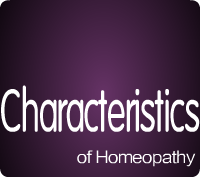 |
|
||||
1. Law of Similarities
Homeopathy advocates "Like cures like" and points out: A healthy person shows the certain symptoms after taking some remedy. If these symptoms are the same as that of a patient due to a disease, the remedy can cure the disease of the patient. This can be illustrated by the example of Hahnemann taking cinchona.
2. Multi-plane diagnosis
The diagnosis of Homeopathy is focused on every symptom of the patient and the general modality, emphasizes on the cause, dynamic change, intensity, location, extension, aggravation factors, relieving factors and so on. Diagnosis is primarily carried out by inquiry, observation and clinical examination. This is somewhat similar to the diagnosis of Chinese Medicine such as observation, smell, ask, and pulse taking. For the deployment of the high-tech equipment and laboratory testing methods for investigation by Western Medicine, the reports are only treated as supplementary reference in the diagnosis.
3. Individualized Holistic Treatment
Since each individual's physical, and genetic factors, etc., are not the same, they have different response to disease. Taking joint pain as an example, some patients may increase the pain under activity, while some others may relieve the pain; For the nasal congestion caused by colds, some people may have congestion at both sides of the nose, while others may have it on one side. Some may have the congestion alternately at each side of the nose, some may have it happen indoor and relieve when going outdoor. From these examples, different patient have different response to different symptom combination on the same disease. Therefore, in order to cure the patient, it is required to use the fully matched remedies with the symptoms of the patient based on the individual condition.
4. Hering's Law of Cure
The direction of cure accomplished by Homeopathy is as follows:
From above downwards,
From within outwards, from a more important organ to a less important one
In the reverse order of their coming
For example, the cure of arthritis starts from the shoulder, and in the order of elbow, wrist, fingers, and finally to the lower limbs, which is from above downwards; For another example, in case of suffering from both asthma and eczema, eczema will be firstly cured and then asthma. This is the law of from within outwards and from a more important organ to a less important one.
5. Infinitiesimal dose
The remedy used by Homeopathy is made by repeated and systematic dilution and potentization (or dynamization). From the point of view in Physics, after the remedy is diluted in 1:99 by 12 times, the attenuation level of the liquid will be beyond the Avogadro’s constant number [S2]. That means there is no more existence of of chemical elements or substances except water. The dilution levels of the commonly used remedies ranged from several times to several million times. Therefore, the therapeutic effect of Homeopathy is physical phenomenon instead of chemical phenomenon.
6. Provings of Remedies
Since Homeopathy was founded by Hahnemann, the curative effect of the remedies have been tested and proven on healthy and keen persons. After the prover takes the remedy under test, he/she can describe his/her feeling on it. Therefore, this proving method can totally reflect the effect of the remedies to the human body.
Based on the above SIX points, it is well illustrated that Homeopathy in terms of theory, diagnosis, treatment and remedy has a great difference with Allopathy of Western Medicine.
References :
- Ramamlal P. Patel, Homeopathy: Its Principles and Doctrines, Hahnemann Homeopathic Pharmacy, India, 1981, Chapter 4 (6), Chapter 4. Principles & Doctrines of Homeopathy, pp. 6-70. C. M. S. Press, Kottayam.